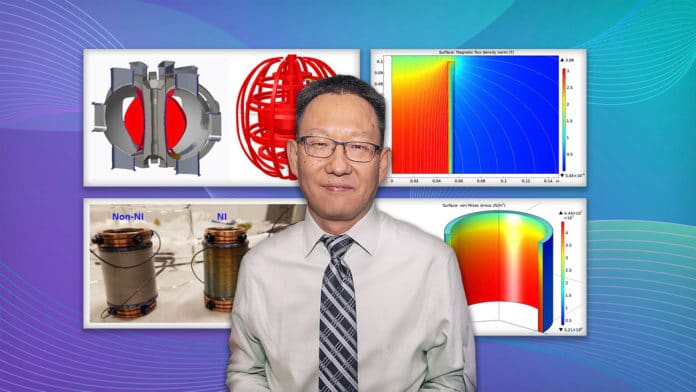Researchers at the U.S. Department of Energy’s (DOE) Princeton Plasma Physics Laboratory (PPPL) have developed a new type of magnet that could improve the performances of devices ranging from doughnut-shaped fusion facilities known as tokamaks to medical machines that create detailed pictures of the human body.
Tokamaks are devices designed to confine the streams of plasma that fuse atoms together under extreme pressure and temperature, releasing huge amounts of energy on an ongoing basis. These devices rely on a central electromagnet, a solenoid, to create an electrical current and magnetic fields that confine the plasma so the fusion reaction can occur. Energetic subatomic particles known as neutrons emanate from the plasma and can degrade insulation surrounding the electromagnet’s wires, which could fail and reduce a tokamak’s ability to harness fusion power.
“If we are designing a power plant that will run continuously for hours or days, then we can’t use current magnets,” said Yuhu Zhai, a principal engineer at PPPL. “Those facilities will produce more high-energy particles than current experimental facilities do. The magnets in production today would not last long enough for future facilities like commercial fusion power plants.”
The new magnets have wires constructed out of the elements niobium, sometimes used in jet engines, and tin, which were heated in a special way to form a new type of superconductor. These new materials allow for electrical current to flow through it at extremely low temperatures with no resistance, which reduces the need for insulation to prevent current leakage.
“During our tests, our magnet produced about 83% of the maximum amount of electrical current the wires can carry, a very good amount,” Zhai said. “Scientists typically only use 70% of the superconducting wire electrical current capacity when designing and building high-power magnets. And large-scale magnets like those used in ITER, the international fusion facility being constructed in France, often use only 50%.”
Researchers say this new concept allows the magnet to carry a lot of electrical current in a little space, reducing the amount of volume the magnet occupies in a tokamak. The new magnet could also operate at higher current densities and stronger magnetic fields than magnets can today. It is also said to be simpler and cheaper to fabricate than current solutions.
“This is a revolutionary change in how you make electromagnets,” said Michael Zarnstorff, PPPL’s Chief Science Officer. “By creating a magnet with just metal and removing the need to use insulation, you get rid of a lot of costly steps and reduce the number of opportunities for the coil to malfunction. This is really important stuff.”
